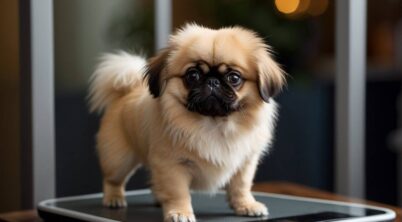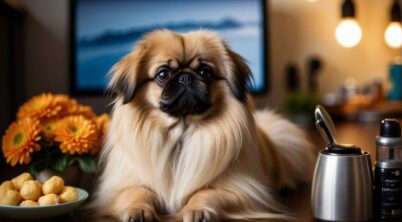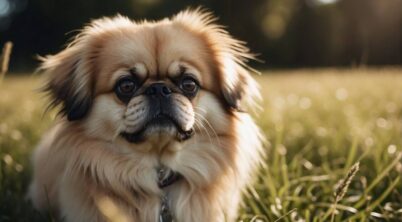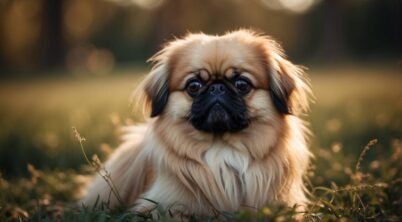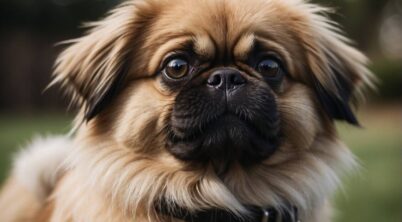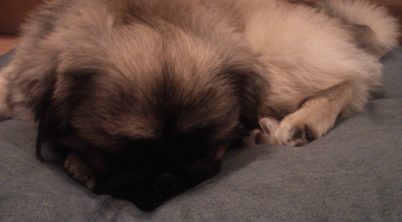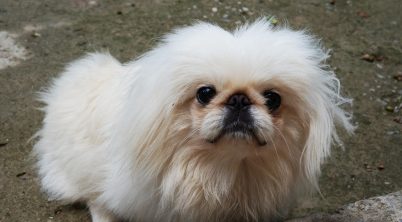The Pekingese is a dog breed steeped in rich history and distinctive qualities that trace back to ancient China. Prized by the Chinese imperial family, these dogs were regarded as a symbol of regal elegance and were often found in the luxurious confines of the palace. Their unique heritage is displayed in their confident comportment and the dignified aura they carry, embodying the essence of the nobility that once exclusively owned them.
Recognized for its compact size and characteristically abundant fur, the Pekingese presents an impression of a canine of greater dimension. This toy breed, aside from its physical traits, holds a temperament that reflects its aristocratic roots. They are known to be independent, sometimes to the point of being perceived as aloof, yet are fiercely loyal to their companions, showing a gentle and affectionate side to those they deem worthy of their trust.
The Pekingese maintains a calm and quiet demeanor when indoors, requiring relatively minimal exercise compared to more active breeds. This, paired with their polite nature towards strangers and general acceptance of other animals, makes them well-suited as companions. Adherence to their majestic lineage, these dogs carry themselves with a distinct rolling gait, which underscores their storied past as cherished members of royalty in ancient China.
Table of Contents
Pekingese Special Qualities
The Pekingese breed boasts several distinctive qualities that set it apart from other dog breeds. Their royal and aristocratic heritage is the most prominent, manifesting in their regal demeanor and posture, reminiscent of its ancient breeding in the Imperial palaces of China.
One of their physical trademarks is their lion-like mane, which is not just a trait but serves the practical purpose of providing a shield against extreme temperatures and minor skirmishes. Pekingeses generally are calm and quiet indoors, requiring less exercise than more active breeds, making them suitable for apartment living.
Here’s a brief outline of their key characteristics:
- Confidence: Displays a dignified and independent personality.
- Size and Appearance: Small-sized, usually weighing up to 14 pounds, with a notable thick fur that makes them appear larger.
- Behavior: Well-mannered with proper guidance, polite to strangers, usually accepts other animals.
- Exercise Needs: Minimal, suited for less active lifestyles.
- Maintenance: Their coat requires regular grooming to maintain their distinct appearance and health.
Furthermore, Pekingeses are known to be observant, often alerting their owners of new guests or changes in their environment. Their vocal behavior is recognized, albeit contrasting with their small stature. Breed enthusiasts describe these dogs as needing special owners who understand and appreciate the unique blend of traits that a Pekingese possesses.
Breed Characteristics
The Pekingese is a breed with distinct physical and personality features that set it apart from other dogs. With its royal heritage, the breed exhibits a unique combination of physical robustness and a dignified temperament.
Physical Traits
The Pekingese, often referred to as the “lion dog,” boasts a bold and stocky figure. They are small in size, typically weighing up to 14 pounds and standing 6 to 9 inches tall at the shoulder. Despite this, they appear larger than life due to their full, luxurious coats. The breed is characterized by brachycephalic features, which include their short snouts and large, expressive eyes framed by a pronounced V-shaped wrinkle.
- Body: Stocky and muscular
- Coat: Thick, with a mane-like appearance around the neck
- Face: Flat snout, with distinct facial wrinkles
Personality and Temperament
Pekingese are known for their intelligent and discerning nature. They carry a dignified presence, reflecting their ancestral roots as companions of Chinese royalty. Though they can be aloof, this breed is also affectionate with its family members, and they can show a playful side.
- Demeanor: Confident and self-assured
- Intelligence: Responsive to training, with a keen awareness of their environment
- Playfulness: Occasionally whimsical, enjoying bouts of play and activity
Caring for a Pekingese
Caring for a Pekingese requires specific attention to their grooming needs and exercise routines due to their unique physical characteristics. Regular maintenance is vital for their overall health and well-being.
Grooming and Coat Maintenance
The Pekingese boasts a luxurious double coat that demands regular grooming to prevent tangles and matting. Weekly brushing is essential, with a daily routine during the shedding seasons of spring and fall. This breed is prone to eye issues due to their prominent eyes; daily cleaning can prevent infections. Owners should include ear cleaning and nail trimming in their care routine.
- Brushing: At least once a week
- Shedding Seasons: Increase to daily brushing
- Eye Cleaning: Daily with a soft, damp cloth
- Ear and Nail Care: Regularly as required
Exercise and Health Considerations
A Pekingese requires moderate exercise to stay healthy. Two short walks per day or play sessions in a garden suit them well. They are at risk of obesity, so diet and exercise must be managed carefully. As a brachycephalic breed, they can suffer from Brachycephalic Airway Obstruction Syndrome; hence, avoiding strenuous exercise, especially in hot weather, is important. Consistent veterinary care is required to monitor any health concerns and keep vaccinations up to date.
- Exercise: Moderate; avoid extreme temperatures
- Obesity Prevention: Controlled diet and regular exercise
- Health Risks: Eye issues, BAOS, obesity
- Veterinary Visits: Regularly for health monitoring
Pekingese in Society
The Pekingese has a distinctive presence in society, recognized for its regal appearance and history, as well as its capability as a companion dog suitable for various living conditions, including apartment living.
Show Dogs and Recognition
The Pekingese, sometimes referred to as the ‘Peke’, has long been associated with dog shows and is consistently recognized for its lion-like mane and unique appearance. It is a breed that commands attention in the show ring, partly due to this luxurious mane which frames the face and provides a noble, lion-like appearance.
- American Kennel Club: The Pekingese is officially recognized and is part of the Toy Group.
- Dog Shows: Regular participants and often winners, showcasing their affectionate and independent temperament.
Companionship and Living Conditions
As a companion dog, the Pekingese excels, offering affection and loyalty to its owners. However, their temperament may sometimes reflect a degree of independence.
- Apartment Living: With their small size, the breed is well-suited for apartment living, although they do require regular grooming due to their thick mane and coat.
- Watchdog: Despite their size, they have a vigilant nature which allows them to be excellent watchdogs, often alerting their owners of new guests or unfamiliar activity.
The Pekingese manages to combine its historical regal bearing from its origins with the practicality and affection offered as a modern-day companion dog. Whether in a show ring or in a cozy apartment setting, they continue to play a significant role in the lives of those they accompany.
Training and Socialization
When it comes to the Pekingese, two crucial aspects of nurturing a well-adjusted dog include a commitment to early socialization and an understanding of the breed’s training challenges.
Early Socialization Importance
The Pekingese breed benefits immensely from early socialization. It is vital that they are exposed to a variety of people, environments, and situations from a young age. This exposure helps them develop into well-rounded adults that are loyal to their families yet accepting of strangers. Consistent, positive interactions during their formative weeks can temper their strong-willed nature, leading to a more adaptable and sociable demeanor.
Training Challenges and Tips
Despite the Pekingese’s intelligent nature, their stubborn and strong-willed characteristics can pose challenges during training. Successful training requires patience, consistency, and a positive reinforcement approach. Here are some tips for effective Pekingese training:
- Consistent Commands: Use clear and consistent commands to communicate with the Pekingese. This consistency helps offset their stubborn streak and promotes understanding.
- Positive Reinforcement: Utilize treats and praise to reward desired behaviors. Positive reinforcement strengthens the bond between owner and dog and reinforces good conduct without the need for harsh discipline.
- Patience is Key: Short, engaging training sessions ensure that the Pekingese does not become bored or resistant to learning.
Remember, the Pekingese may not respond to a traditional authoritarian training method, and a respectful, tailored approach to training is a testament to their aristocratic heritage.

